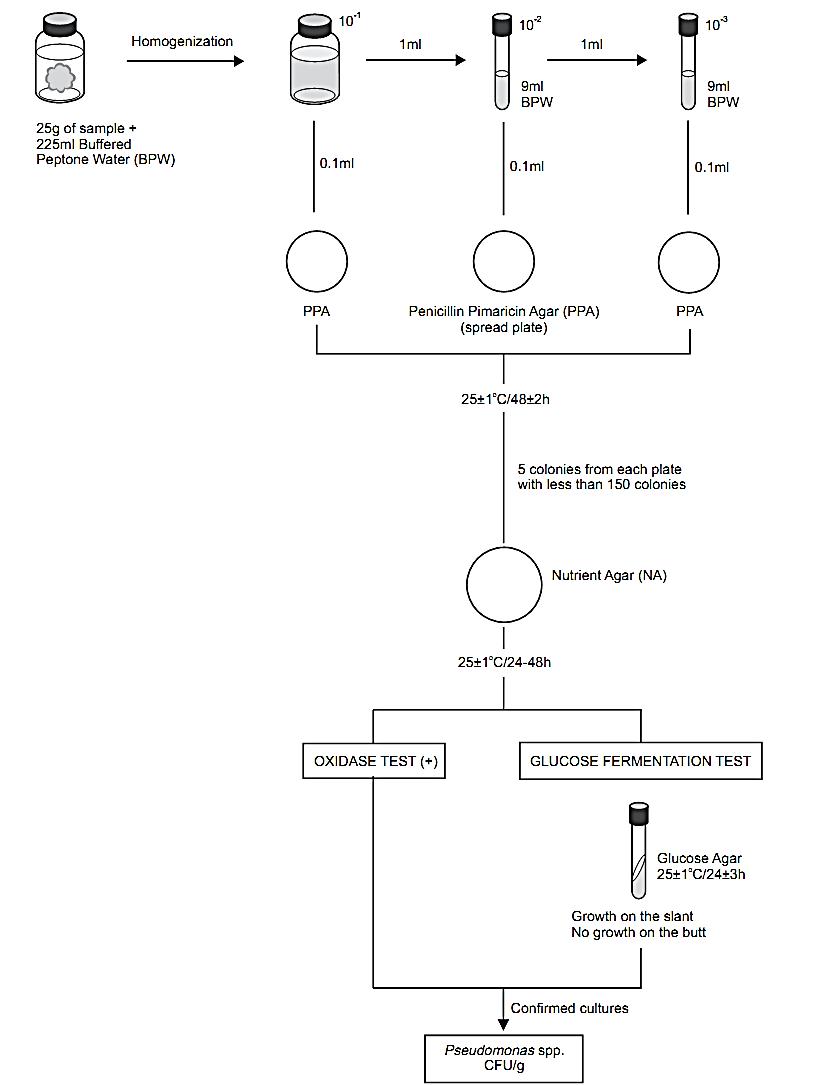


 النبات
النبات
 الحيوان
الحيوان
 الأحياء المجهرية
الأحياء المجهرية
 علم الأمراض
علم الأمراض
 التقانة الإحيائية
التقانة الإحيائية
 التقنية الحيوية المكروبية
التقنية الحيوية المكروبية
 التقنية الحياتية النانوية
التقنية الحياتية النانوية
 علم الأجنة
علم الأجنة
 الأحياء الجزيئي
الأحياء الجزيئي
 علم وظائف الأعضاء
علم وظائف الأعضاء
 الغدد
الغدد
 المضادات الحيوية
المضادات الحيوية| Plate count method ISO 11059:2009 IDF/RM 225:2009 for Pseudomonas spp. in milk and milk products |
|
|
|
Read More
Date: 10-3-2016
Date: 20-3-2016
Date: 2025-01-21
|
Plate count method ISO 11059:2009 IDF/RM 225:2009 for Pseudomonas spp. in milk and milk products
This method of the International Organization for Standardization and the International Dairy Federation is applicable to milk and milk products. It is also applicable to dairy environmental samples.
1. Material required for analysis
Preparation of the sample and serial dilutions
• Diluent: 0.1% Peptone Water (PW) or Buffered Peptone Water (BPW) or Saline Peptone Water (SPW) or Ringer’s Solution Quarter-Strength or Phosphate Buffered Solution according ISO 6887-5:2010.
• Dilution tubes containing 9 ml of 0.1% Peptone Water (PW) or Buffered Peptone Water (BPW) or Saline Peptone Water (SPW) or Ringer’s Solution Quarter-Strength or Phosphate Buffered Solution according ISO 6887-5:2010.
Enumeration of Pseudomonas spp.
• Penicillin Pimaricin Agar (PPA)
• Nutrient Agar (NA)
• Glucose Agar
• Oxidase Kovacs Reagent
• Laboratory incubator set to 25 ± 1°C
2 . Procedure
A general flowchart for the enumeration of Pseudomonas spp. in milk and milk products using the plate count method ISO 11059:2009 is shown in
a) Preparation of the samples, inoculation and incubation: For the preparation of the sample and serial dilutions . Select three appropriate dilutions of the sample and inoculate 0.1 ml of each dilution on Penicillin Pimaricin Agar (PPA) plates, using the spread plating technique.
Note a.1) Three dilutions are the number usually inoculated, but the ISO 7218:2007 allows the inoculation of less than three dilutions. When at least two successive dilutions are inoculated, only one plate per dilution is required. If only one dilution is inoculated, then two plates are required.
Incubate the plates (without inverting) at 25 ± 1°C/48 ± 2 h. Count all the colonies on each plate and select plates with less than 150 colonies for confirmation.
b) Confirmation: From each plate with less than 150 colonies, select five for confirmation. If there are fewer than five, select all. Streak each colony onto a Nutrient Agar (NA) plate and incubate at 25 ± 1°C/24–48 h. Select one well isolated colony from each NA plate for the confirmatory tests.
b.1) Oxidase test: Using a platinum/iridium loop or glass rod, take a portion the colony and streak it onto a filter paper moistened with the Oxidase Kovacs Reagent. The appearance of a violet to purple color within 10s indicates a positive reaction. If the color has not changed after 30s, the test is considered negative.
b.2) Fermentation of glucose: From the colony on NA inoculate tubes of Glucose Agar by stabbing. Incubate the tubes at 25 ± 1°C/24 ± 3 h (if screw cap tubes are used, the caps must be loosened). The test is considered negative for cultures showing growth but no color change to yellow (glucose not fermented). Glucose oxidation may result in yellow color at the agar surface (negative test for fermentation).
c) Calculation of the results: Consider as Pseudomonas spp. the cultures showing positive oxidase test and negative glucose fermentation test. Calculate the results following the same orientations described in method ISO 13720:2010.
Note c1) In the description of the genera Pseudomonas (Palleroni, 2005a) the oxidase test is positive for most species but there are negative strains, not considered in this calculation of results.

Figure 1 Scheme of analysis for the enumeration of Pseudomonas spp. in milk and milk products using the plate count method ISO 11059:2009.
References
Silva, N.D .; Taniwaki, M.H. ; Junqueira, V.C.A.; Silveira, N.F.A. , Nasdcimento , M.D.D. and Gomes ,R.A.R .(2013) . Microbiological examination methods of food and water a laboratory Manual. Institute of Food Technology – ITAL, Campinas, SP, Brazil .
International Organization for Standardization (2010) ISO 13720:2010. Meat and meat products – Enumeration of presumptive Pseudomonas spp. Geneva, ISO.
International Organization for Standardization (2009) ISO 11059:2009. Milk and milk products – Method for the enumeration of Pseudomonas spp. Geneva, ISO.
International Organization for Standardization (2007) ISO 7218:2007. Microbiology of food and animal stuffs – General requirements and guidance for microbiological examinations. Geneva, ISO.



|
|
|
|
لشعر لامع وكثيف وصحي.. وصفة تكشف "سرا آسيويا" قديما
|
|
|
|
|
|
|
كيفية الحفاظ على فرامل السيارة لضمان الأمان المثالي
|
|
|
|
|
|
|
قسم الشؤون الفكرية يصدر مجموعة قصصية بعنوان (قلوب بلا مأوى)
|
|
|